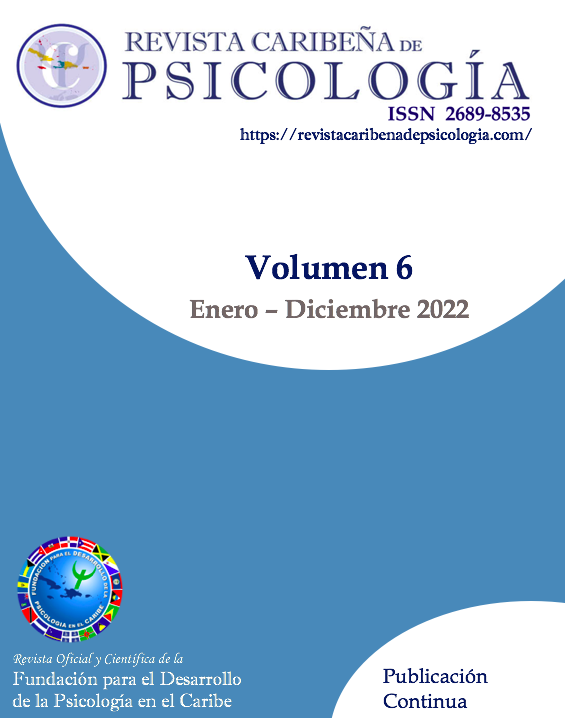Development and Validation of the Job Satisfaction Brief Scale
DOI:
https://doi.org/10.37226/rcp.v6i1.6191Keywords:
Confirmatory Factor Analysis, Exploratory Factor Analysis, Internal Structure, Job Satisfaction, Measurement Invariance, Psychometric PropertiesAbstract
This research aimed to develop and validate an instrument to measure job satisfaction in general. A total of 1,491 employed people who worked at least 20 hours per week and were 21 years of age or older participated in the study. The Job Satisfaction Brief Scale was developed with a total of eight items. Several exploratory factor analyses and several confirmatory factor analyses were performed using structural equation modeling to examine the scale's internal structure. The final version of the scale was composed of four items for which Cronbach's alpha and McDonald's omega coefficients were examined and fluctuated between .77 to .78. The results of the factor analyses, especially the confirmatory one, support the one-dimensional internal structure. The new scale appears to be invariance among gender, age, job position, and type of organization. In this way, the results provide evidence of the validity and reliability of the instrument created to measure job satisfaction in general.
References
Begley, T.M. & Czajka, J.M. (1993). Panel analysis of the moderat-ing effects of commitment on job satisfaction, intent to quit, and health following organizational change. Journal of Applied Psychology, 78, 552-556.
Bright, L. (2021). Does perceptions of organizational prestige mediate the relationship between public service motivation, job satisfaction, and the turnover intentions of federal em-ployees? Public Personnel Management, 50 (3), 408-429. https://doi.org/10.1177%2F0091026020952818
Browne, M. W. & Cudeck, R. (1989). Single sample cross-validation indices for covariance structures. Multivariate Be-havioral Research, 24, 445-455. https://doi.org/10.1207/s15327906mbr2404_4
Byrne, B. M. (2016). Structural equation modeling with AMOS: Basic concepts, applications, and programming. New York, NY: Routledge.
Campbell, D. T., & Fiske, D. W. (1959). Convergent and discrimi-nant validation by the multitrait-multimethod matrix. Psycho-logical Bulletin, 56(2), 81-105. https://doi.org/10.1037/h0046016
Cammann, C., Fichman, M., Jenkins, D., & Klesh, J. (1979). The Michigan Organizational Assessment Questionnaire. Unpublished manuscript, University of Michigan, Ann Harbor.
Carsten, J.M. & Spector, P.E. (1987). Unemployment, job satisfac-tion, and employee turnover: A meta-analytic test of the Muchinski model. Journal of Applied Psychology, 72, 374-381.
Choi, M., Suh, C., Choi, S. P., Lee, C. K., & Son, B. C. (2020). Validation of the Work Engagement Scale-3, used in the 5th Korean Working Conditions Survey. Annals of occupational and environmental medicine, 32, e27. https://doi.org/10.35371/aoem.2020.32.e27
Chen, F. F. (2007). Sensitivity of goodness of fit indexes to lack of measurement invariance. Structural Equation Modeling, 14, 464-504. https://psycnet.apa.org/doi/10.1080/10705510701301834
Dawis, R.V. (2004). Job satisfaction. In J.C. Thomas (Ed.), Compre-hensive handbook of psychological assessment (Vol. 4, pp. 470-481). Hoboken, NJ: Wiley.
DeVellis, R. F. (2017). Scale Development: Theory and Applications. Thousand Oaks, CA: SAGE Publications.
Ekhsan, M. (2019). The influence job satisfaction and organiza-tional commitment on employee turnover intention. Journal of Business Management in Account, 1, 48–55.
Fornell, C., & Bookstein, F. L. (1982). Two structural equation models: LISREL and PLS applied to consumer exit-voice the-ory. Journal of Marketing Research, 19(4), 440-452. https://doi.org/10.2307/3151718
Fornell, C., & Larcker, D. F. (1981). Evaluating structural equation models with unobservable variables and measurement er-ror. Journal of Marketing Research, 18(1), 39-50. https://doi.org/10.2307/3151312
Ganster, D.C., Hennessey, H.W., & Luthans, F. (1983). Social desirability response effects: Three alternative models. Acade-my of Management Journal, 26, 321-331.
Gebregziabher, D., Berhanie, E., Berihu, H, Belstie, A., & Teklay, G. (2020). The relationship between job satisfaction and turn-over intention among nurses in Axum comprehensive and specialized hospital Tigray, Ethipia. BMC Nursing, 19, 79. https://doi.org/10.1186/s12912-020-00468-0
Green, S.B. & Yang, Y. (2009). Reliability of Summed Item Scores Using Structural Equation Modeling: An Alternative to Coef-ficient Alpha. Psychometrika, 74, 155-167. https://doi.org/10.1007/s11336-008-9099-3
Hackman, J. R., & Oldham, G. R. (1975). Development of the Job Diagnostic Survey. Journal of Applied Psychology, 60(2), 159-170. https://doi.org/10.1037/h0076546
Hair, J.F., Black, W.C., Babin, B.J., & Anderson, R.E. (2019). Multi-variate data analysis. Hampshire, UK: Cengage.
Halbesleben, J. R. B. (2010). A meta-analysis of work engagement: Relationships with burnout, demands, resources, and conse-quences. In A. B. Bakker & M. P. Leiter (Eds.), Work engage-ment: A handbook of essential theory and research (pp. 102-117). New York: Psychology Press.
Hankins, M. (2008). The factor structure of the twelve item General Health Questionnaire (GHQ-12): The result of nega-tive phrasing? Clinical Practice and Epidemiology in Mental Health, 4, Article 10. https://doi.org/10.1186/1745-0179-4-10
Häusser, J.A., Mojzisch, A., Niesel, M., & Schulz-Hardt, S. (2010). Ten years on: A review of recent research on the Job De-mand-Control (-Support) model and psychological well-being. Work & Stress, 24(1), 1-35. https://psycnet.apa.org/doi/10.1080/02678371003683747
Hayes, A. F. & Coutts, J. J. (2020). Use omega rather than cronbach’s alpha for estimating reliability. Communication Methods and Measures, 14(1), 1-24. https://doi.org/10.1080/19312458.2020.1718629
Hu, L.-t., & Bentler, P. M. (1999). Cutoff criteria for fit indexes in covariance structure analysis: Conventional criteria versus new alternatives. Structural Equation Modeling, 6(1), 1-55. https://doi.org/10.1080/10705519909540118
Hulin, C.L & Judge, T.A. (2003). Job attitudes. In W.C. Borman, D.R. Ilgen, & R.J. Klimoski (Eds.), Handbook of psychology (Vol. 12): Industrial and organizational psychology (pp. 255-276). Hobeken, NJ: Wiley.
Ironson, G.H., Smith, P.C., Brannick, M.T., Gibson, W.M., & Paul, K.B. (1989). Constitution of a Job in General Scale: A compari-son of global, composite, and specific measures. Journal of Ap-plied Psychology, 74(2), 193-200. http://doi.org/10.1037/0021-9010.74.2.193
Johns, G. (1997). Contemporary research on absence from work: Correlates, causes, and consequences. In C.L. Cooper & I.T. Robertson (Eds.), International review of industrial and organiza-tional psychology (Vol. 12, pp.115-173). Chichester: Wiley.
Judge, T.A., Thoresen, C.J., Bono, J.E., & Patton, G.K. (2001). The job satisfaction-job performance relationship: A qualitative and quantitative review. Psychological Bulletin, 127, 376-407.
Karanika-Murray, M., Duncan, N., Pontes, H.M., & Griffiths, M.D. (2015). Organizational identification, work engagement, and job satisfaction. Journal of Managerial Psychology, 30(8), 1019-1033.
Kenny, D. A., Kaniskan, B., & McCoach, D. B. (2015). The per-formance of RMSEA in models with small degrees of free-dom. Sociological Methods & Research, 44(3), 486–507. https://doi.org/10.1177/0049124114543236
Kline, P. (1994). An easy guide to factor analysis. London, UK: Routledge.
Kline, R.B. (2016). Principles and practice of structural equation model-ing. New York, NY: The Guilford Press.
Lambert, E., Lynne Hogan, N., & Barton, S. (2001). The impact of job satisfaction on turnover intent: A test of a structural measurement model using a national sample of workers. The Social Science Journal, 38(2), 233–250.
Lee, R.T. & Ashforth, B.E. (1993). A further examination of mana-gerial burnout: Toward an integrated model. Journal of Organ-izational Behavior, 14, 3-20.
Li, C.H. (2016a). Confirmatory factor analysis with ordinal data: Comparing robust maximum likelihood and diagonally weighted least squares. Behavioral Research Methods, 48(3), 936-949. https://doi.org/10.3758/s13428-015-0619-7
Li, C.-H. (2016b). The performance of ML, DWLS, and ULS esti-mation with robust corrections in structural equation models with ordinal variables. Psychological Methods, 21(3), 369-387. https://doi.org/10.1037/met0000093
Lum, L., Kervin, J., Clark, K., Reid, F., & Sirola, W. (1998). Explain-ing nursing turnover intent: Job satisfaction, pay satisfaction, or organizational commitment? Journal of Organizational Be-havior, 19(3), 305–320.
MacCallum, R.C., Browne, M.W., & Sugawara, H.M. (1996). Power analysis and determination of sample size for covari-ance structure modeling. Psychological Methods, 1, 130-139. https://doi.org/10.1037/1082-989X.1.2.130
Marsh, H. W., Balla, J. R., & Hau, K. T. (1996). An Evaluation of Incremental Fit Indexes: A Clarification of Mathematical and Empirical Properties. In G. A. Marcoulides, & R. E. Schu-macker (Eds.), Advanced Structural Equation Modeling Tech-niques (pp. 315-353). Mahwah, NJ: Lawrence Erlbaum.
Martínez-Alvarado, L.Y., Rosario-Hernández, E., & Rovira-Millán, L.V. (2017). La relación entre la inseguridad laboral y el bienestar psicológico en una muestra de asistentes de vuelo: El papel moderador del engagement en el trabajo. Ciencias de la Conducta, 32(1), 99-127.
Maslach, C., Jackson, S. E., and Leiter, M. P. (1996). Maslach Burnout Inventory manual. Palo Alto, CA: Consulting Psy-chologists Press.
Maslach, C., & Schaufeli, W. (1993) Historical and conceptual development of burnout. In Schaufeli, W., Maslach, C., & Marek, T. (Ed.), Professional Burnout: Recent Developments in Theory and Practice. Washington, DC: Taylor & Francis.
McCrae, R. R., Kurtz, J. E., Yamagata, S., & Terracciano, A. (2011). Internal consistency, retest reliability, and their implications for personality scale validity. Personality and Social Psychology Review, 15(1), 28–50. https://doi.org/10.1177/1088868310366253
Meredith, W., & Teresi, J. A. (2006). An Essay on Measurement and Factorial Invariance. Medical Care, 44(11, Suppl 3), S69-S77. https://doi.org/10.1097/01.mlr.0000245438.73837.89
Michaels, C. E., & Spector, P. E. (1982). Causes of employee turn-over: A test of the Mobley, Griffeth, Hand, and Meglino model. Journal of Applied Psychology, 67(1), 53-59. http://dx.doi.org/10.1037/0021-9010.67.1.53
Mobley, W. H. (1977). Intermediate linkages in the relationship between job satisfaction and employee turnover. Journal of Applied Psychology, 62(2), 237–240.
Molero-Jurado, M., Pérez-Fuentes, M., Atria, L., Oropesa-Ruiz, N.F., Gázquez-Linares, J.J. (2019). Burnout, perceived effica-cy, and job satisfaction: Perception of the educational context in high school teachers. BioMed Research International, 2019, 1021408, 10 pages. https://doi.org/10.1155/2019/1021408
Moorman, R.H. & Podsakoff, P.M. (1992). A meta-analytic review and empirical test of the potential confounding effects of so-cial desirability response sets in organizational behaviour re-search. Journal of Occupational and Organizational Psychology, 65, 131-149.
Muchinsky, P.M. (2012). Psychology applied to work: An introduc-tion to industrial and organizational psychology. Summerfield, NC: Hypergraphics Press, Inc.
Muthén, L. K., and Muthén, B. O. (1998–2012). Mplus User’s Guide. Los Angeles, CA: Muthén & Muthén.
Orgambidez, A. & Extremera, N. (2020). Understanding the link between work engagement and job satisfaction: Do role stressors underlie this relationship? Scandinavian Journal of Psy-chology, 61(30), 443-449. https://doi.org/10.1111/sjop.12613
Panthee, B., Shimazu, A., Kawakami, N. (2014). Validation of Nepalese version of Utrecht Work Engagement Scale. Journal of Occupational Health, 56(6), 421-429.
Ponterotto, J. G. & Ruckdeschel, D. E. (2007). An overview of coefficientalpha and a reliability matrix for estimating ade-quacy of internal consistencycoefficients with psychological research measures. Perception and Motor Skills, 105, 997-1014. https://doi.org/10.2466/pms.105.3.997-1014
Riggar, T.F., Godley, S.H., & Hafer, M. (1984). Burnout and job satisfaction in rehabilitation administrators and direct service providers. Rehabilitation Counseling Bulletin, 27, 151-160.
Rigdon, E. E. (1995). A necessary and sufficient identification rule for structural models estimated in practice. Multivariate Behavioral Research, 30(3), 359-383. https://doi.org/10.1207/s15327906mbr3003_4
Rodríguez-Montalbán, R., Martínez-Lugo, M.E., Andújar-Rojas, C.A. (2011, marzo). Análisis de las Propiedades de la Escala de Engagement en el Trabajo de Utrecht en un grupo de empleados/as en Puerto Rico. Ponencia presentada en el Primer Congreso de Psicología Industrial Organizacional de Puerto Rico: “Acciones Estratégicas para la Gestión del Capital Humano,” Ponce, Puerto Rico.
Rosario-Hernández, E. & Rovira-Millán, L.V. (2002). Desarrollo y validación de una escala para medir actitudes hacia el retiro. Revista Puertorriqueña de Psicología, 13, 45-60.
Rosario-Hernández, E. & Rovira-Millán, L.V. (2018). Development and validation of the Turnover Intention Scale. Unpublished manuscript.
Rosario-Hernández, E., Rovira Millán, L.V., & Merino-Soto, C. (2021). Review of the Internal Structure, Psychometric Prop-erties, and Measurement Invariance of the Work-Related Rumination Scale – Spanish Version. Frontiers in Psychology, 12. https://www.frontiersin.org/article/10.3389/fpsyg.2021.774472
Rosario-Hernández, E., Rovira Millán, L.V., Vélez Ramos, J., Cruz, M., Vélez, E., Torres, G., Alomar, G., Caldera, J., Santiago, M., Arroyo, Y., Sánchez, I., & Rodríguez, N. (2018). Effect of the exposure to workplace bullying on turnover intention and the mediating role of job satisfaction, work engagement, and burnout. Revista Interamericana de Psicología Ocupacional, 37(1), 26-51. https://doi.org/10.21772/ripo.v37n1a03
Rosseel, Y. (2012). lavaan: An R Package for Structural Equation Modeling. Journal of Statistical Software, 48(2), 1-36. https://www.jstatsoft.org/v48/i02/
Schaufeli, W., & Bakker, A. (2003). Utrecht work engagement scale: Preliminary manual. Utrecht: Occupational Health Psychology Unit, Utrecht University.
Schaufeli, W.B., Salanova, M., González-Romá, V., Bakker, A.B. (2002). The measurement of engagement and burnout: A confirmative analytic approach. Journal of Happiness Studies, 3, 7-92. https://doi.org/10.1023/A:1015630930326
Schmitt, N., & Stults, D. M. (1985). Factors defined by negatively keyed items: The results of careless respondents? Applied Psy-chological Measurement, 9, 367-373. https://doi.org/10.1177/014662168500900405
Shi, D., DiStefano, C., Maydeu-Olivares, A., & Lee, T. (2021). Evaluating SEM Model Fit with Small Degrees of Free-dom. Multivariate behavioral research, 1-36. https://doi.org/10.1080/00273171.2020.1868965
Smith, P.C., Kendall, L.M., & Hulin, C.L. (1969). Measurement of job satisfaction in work and retirement. Chicago: Rand McNally.
Spector, P. E. (1985). Measurement of human services staff satis-faction: Development of the Job Satisfaction Survey. American Journal of Community Psychology, 13, 693-713.
Spector, P. E. (1992). Summated rating scale construction: An intro-duction. Newbury Park, CA: SAGE Publications.
Spector, P. E. (1997). Job satisfaction: Application, assessment, causes, and consequences. Thousand Oaks, CA: SAGE Publi-cations.
Spector, P. E., Dwyer, D. J., & Jex, S. M. (1988). Relation of job stressors to affective, health, and performance outcomes: A comparison of multiple data sources. Journal of Applied Psy-chology, 73(1), 11-19. http://dx.doi.org/10.1037/0021-9010.73.1.11
Vandenberg, R. J., & Lance, C. E. (2000). A review and synthesis of the measurement invariance literature: Suggestions, prac-tices, and recommendations for organizational research. Or-ganizational Research Methods, 3(1), 4-69. https://doi.org/10.1177/109442810031002
van der Doef, M. & Maes, S. (1999). The job demand-control (-support) model and psychological well-being: A review of 20 years of empirical research. Work & Stress, 13(2), 87-114. https://doi.org/10.1080/026783799296084
Wall, T.D. (1972). Overall job satisfaction in relation to 'social desirability', age, length of employment and social class. British Journal of Social and Clinical Psychology, 11(1), 79-81. https://doi.org/10.1111/j.2044-8260.1972.tb00782.x
Wang, J. & Wang, X. (2012). Structural Equation Modeling Applica-tions Using Mplus. Chichester: John Wiley & Sons Ltd. https://doi.org/10.1002/9781118356258
Weiss, D.J., Dawis, R.V., England, G.W., & Lofquist, L.H. (1967). Manual for the Minnesota Satisfaction Questionnaire (Minnesota Studies in Vocational Rehabilitation, No. 22). University of Minnesota, Minneapolis. https://vpr.psych.umn.edu/sites/vpr.umn.edu/files/files/monograph_xxii_-_manual_for_the_mn_satisfaction_questionnaire.pdf
Zedeck, S., Maslach, C., Mosier, K., & Skitka, L. (1988). Affective response to work and quality of family life: Employee and spouse perspectives. Journal of Social Behavior and Personality, 3(4), 135-157.
Zhang, T. & Li, B. (2020). Job crafting and turnover intention: The mediating role of work engagement and job satisfaction. Social Behavior and Personality, 48(2), e8759. https://doi.org/10.2224/sbp.8759
Downloads
Published
How to Cite
Issue
Section
License
Copyright (c) 2022 Ernesto Rosario-Hernández, Lillian V. Rovira-Millán, Rafael A. Blanco-Rovira

This work is licensed under a Creative Commons Attribution 4.0 International License.







